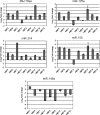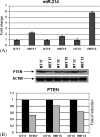Altered microRNA Expression Patterns in Hepatoblastoma Patients
- PMID: 19701500
- PMCID: PMC2730135
- DOI: 10.1593/tlo.09124
Altered microRNA Expression Patterns in Hepatoblastoma Patients
Abstract
Liver cancers in children are rare representing only 1.1% of malignancies, with an annual incidence rate of 1.5 cases per million. Hepatoblastoma and hepatocellular carcinomas are the most common malignancies of the liver occurring in young people aged 15 years or younger. Molecular basis of both tumors are still unclear, and common markers (i.e., CTNNB1, APC, IGF-2) are not always useful in the characterization of sporadic forms; in this respect, microRNA recently associated with carcinogenesis could play a pivotal role in their onset. CTNNB1 and APC were analyzed by sequencing, and IGF-2 promoter methylation status was assessed by methylation-specific polymerase chain reaction. MicroRNA expression was assayed by microarray and quantitative reverse transcription-polymerase chain reaction in hepatoblastoma samples. Although few genomic alterations were detected in ours samples, an altered expression of somemicroRNA in hepatoblastoma was observed. Unsupervised clustering shows that microRNA profile can distinguish tumor from nontumor tissues. Further analyses of microRNA contents in hepatoblastoma compared with hepatocellular carcinoma highlighted four upregulated microRNA (miR-214, miR-199a, miR-150 [P < .01], and miR-125a [P < .05]) and one downregulated microRNA (miR-148a [P < .01]). In conclusion, although our samples were poorly informative from a genetic point of view, they showed a peculiar microRNA expression pattern compared with nontumor tissues and hepatocellular carcinoma. MicroRNA could represent valid markers for the classification of pediatric liver tumors.
Figures



Similar articles
-
MicroRNA profiling in hepatocellular tumors is associated with clinical features and oncogene/tumor suppressor gene mutations.Hepatology. 2008 Jun;47(6):1955-63. doi: 10.1002/hep.22256. Hepatology. 2008. PMID: 18433021
-
Serum microRNA-125a-5p as a potential biomarker of HCV-associated hepatocellular carcinoma.Oncol Lett. 2019 Jul;18(1):882-890. doi: 10.3892/ol.2019.10385. Epub 2019 May 21. Oncol Lett. 2019. PMID: 31289566 Free PMC article.
-
Relevance of microRNA-18a and microRNA-199a-5p to hepatocellular carcinoma recurrence after living donor liver transplantation.Liver Transpl. 2016 May;22(5):665-76. doi: 10.1002/lt.24400. Liver Transpl. 2016. PMID: 26783726
-
Integrative analysis of aberrant Wnt signaling in hepatitis B virus-related hepatocellular carcinoma.World J Gastroenterol. 2015 May 28;21(20):6317-28. doi: 10.3748/wjg.v21.i20.6317. World J Gastroenterol. 2015. PMID: 26034368 Free PMC article. Review.
-
Recent updates on the classification of hepatoblastoma according to the International Pediatric Liver Tumors Consensus.J Liver Cancer. 2022 Mar;22(1):23-29. doi: 10.17998/jlc.2022.02.24. Epub 2022 Mar 17. J Liver Cancer. 2022. PMID: 37383535 Free PMC article. Review.
Cited by
-
Diagnostic value and prognostic significance of LI-cadherin and miR-378e in colorectal cancer.Oncol Lett. 2020 Sep;20(3):2456-2464. doi: 10.3892/ol.2020.11755. Epub 2020 Jun 19. Oncol Lett. 2020. PMID: 32782563 Free PMC article.
-
Functional screening for miRNAs targeting Smad4 identified miR-199a as a negative regulator of TGF-β signalling pathway.Nucleic Acids Res. 2012 Oct;40(18):9286-97. doi: 10.1093/nar/gks667. Epub 2012 Jul 19. Nucleic Acids Res. 2012. PMID: 22821565 Free PMC article.
-
MicroRNAs and Long Non-coding RNAs in Genetic Diseases.Mol Diagn Ther. 2019 Apr;23(2):155-171. doi: 10.1007/s40291-018-0380-6. Mol Diagn Ther. 2019. PMID: 30610665 Free PMC article. Review.
-
Multi-platform microRNA profiling of hepatoblastoma patients using formalin fixed paraffin embedded archival samples.Gigascience. 2015 Nov 25;4:54. doi: 10.1186/s13742-015-0099-9. eCollection 2015. Gigascience. 2015. PMID: 26613016 Free PMC article.
-
microRNA-148a inhibits hepatocellular carcinoma cell invasion by targeting sphingosine-1-phosphate receptor 1.Exp Ther Med. 2015 Feb;9(2):579-584. doi: 10.3892/etm.2014.2137. Epub 2014 Dec 16. Exp Ther Med. 2015. PMID: 25574238 Free PMC article.
References
-
- Roebuck DJ, Perilongo G. Hepatoblastoma: an oncological review. Pediatr Radiol. 2006;36:183–186. - PubMed
-
- McLaughlin CC, Baptiste MS, Schymura MJ, Nasca PC, Zdeb MS. Maternal and infant birth characteristics and hepatoblastoma. Am J Epidemiol. 2006;163:818–828. - PubMed
-
- Reynolds P, Urayama KY, Von Behren J, Feusner J. Birth characteristics and HB risk in young children. Cancer. 2004;100:1070–1076. - PubMed
-
- Nagata T, Nakamura M, Shichino H, Chin M, Sugito K, Ikeda T, Koshinaga T, Fukuzawa M, Inoue M, Mugishima H. Cytogenetic abnormalities in HB: report of two new cases and review of the literature suggesting imbalance of chromosomal regions on chromosomes 1, 4, and 12. Cancer Genet Cytogenet. 2005;156:8–13. - PubMed
LinkOut - more resources
Full Text Sources
Other Literature Sources
Miscellaneous
